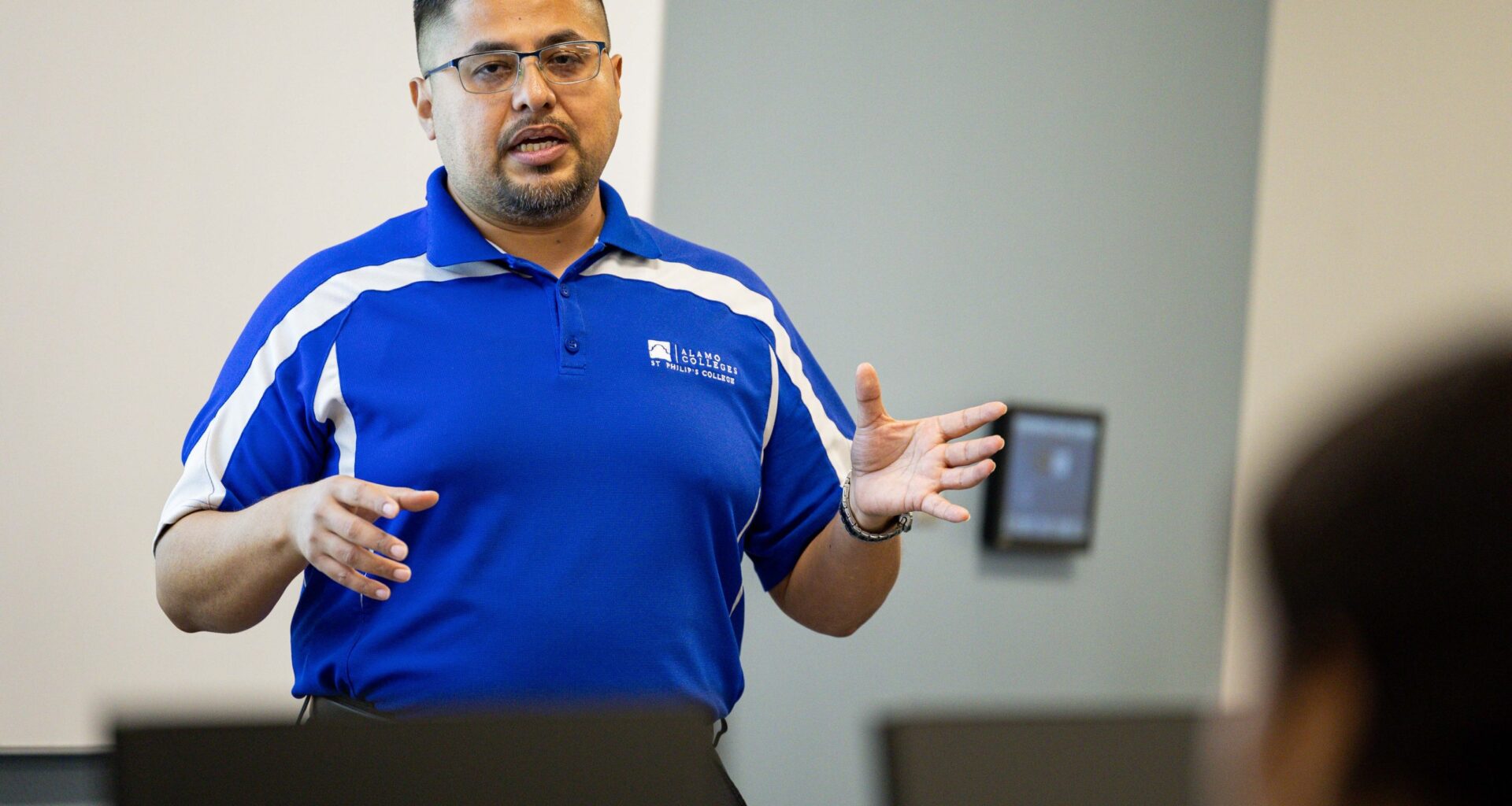On a recent Monday evening, as Luis Sevilla waited for his students to arrive to his Learning Frameworks class at St. Philip’s College, he displayed a website on the whiteboard to remind them of the resources the college offers; from financial help with living expenses, to free bus rides, to childcare.
“It is probably the easiest class that they’ll take because it just teaches them how to be better students, how to be well organized,” Sevilla said. “But it’s the hardest class that I have to teach because, again, I need to get them prepared for the college experience.”
In order to be qualified to teach classes, Sevilla knew he needed his master’s degree, and the opportunity to acquire it presented itself through his own Alamo Colleges District colleagues who recommended a program through the University of Texas at San Antonio’s Department of Educational Leadership and Policy Studies.
Twice a week a cohort of Alamo Colleges staff members from across all five colleges — St. Philip’s College, San Antonio College, Palo Alto College, Northwest Vista College, Northeast Lakeview College — gather at San Antonio College to take evening courses in a graduate program specifically designed for their needs and expertise.
The 2-year master of education in higher education administration welcomes part-time and full-time staff members at Alamo Colleges to apply. The program uses a technique called “reflective practice” to utilize the experience the college professionals already have in the field to inform their learning. This fall, UT San Antonio will graduate its fifth Alamo Colleges cohort.
“It validated the work that I do here,” Sevilla said about the program. “The master’s program specifically caters to the students that we serve here … in every topic we covered I was like ‘Oh my God, I do this at work and this is what they are referring to!’ Every class was like that.”
Sevilla entered the part-time master’s program in 2021 and graduated in 2023, he is now one of more than 40 Alamo Colleges District staff members who have taken advantage of the course since its official inception in 2020, when the two institutions signed a memorandum of understanding after piloting the program for a handful of years.
The program’s development dates back to 2015, when UT San Antonio researched the role of community colleges as Hispanic Serving Institutions in regions like San Antonio.
“It makes sense here in South Texas, given that Alamo Colleges is one of the largest education systems,” said Vanessa Sansone, co-director of the Department of Educational Leadership and Policy Studies at UT San Antonio.
With nearly 88,000 students attending all five Alamo Colleges, Sansone said it made sense to tailor this program to the staff’s experience so that they can immediately put some of their learning into practice.
Out of the 41 professionals that have entered the program, 40 remain employed at Alamo Colleges. Some might immediately apply for better roles, and others, like Sevilla will utilize this degree to better inform the jobs they currently have and add other responsibilities, Sansone said.
The university offers discounted rates for this program, as the agreement calls for the classes to take place at an Alamo College campus, in this case San Antonio College, in efforts to make it a more central location for the entire group. They also offer online books and class materials to offset the additional costs.
Evelyn Gonzalez, enrollment team lead in the student success division at Palo Alto College, is getting ready to graduate this December. She heard about the graduate program through colleagues at Palo Alto College who had earned their degrees, but wasn’t sure she was ready to go back to school.
“Funny enough, I applied on the very last day,” Gonzalez said. “I (would be) going back to get my masters after five years of getting my bachelor’s degree … so it meant learning how to manage my full-time job, how to read (assignments) again, as simple as it sounds, even do research.”
Despite the fear, Gonzalez sent in her application knowing that her goal had always been to continue growing, both personally and professionally, she said. And once she got accepted and started the program, she said she was also surprised by how relatable the program is.
“I’ve definitely grown,” Gonzalez said. “It’s helped me lead a lot better. Meeting not just students’ needs but my team’s needs as professionals.”
The growth she was seeking was of course professional, she said, but she also wanted to challenge the system. Gonzalez was diagnosed at a young age with spinal muscular atrophy and today she uses a wheelchair.
She said people’s expectations of what they thought she could achieve were often limiting, but she worked hard to prove that she could define and achieve her own goals. These are also some of the invisible barriers that her students could be facing, she said, with many of them being the first to attend and hopefully the first to graduate college in their families.
Both Gonzalez and Sevilla are first-generation college students, who are working to pave the way for many other students who walk through the doors of their respective campuses. The program aims to provide them the tools necessary to excel at their current jobs, seek new pathways and ultimately, better serve their communities.
“I am looking into maybe getting into a doctoral program,” Gonzalez said. “I just got promoted nine months ago to the enrollment team lead position, so I love what I do. I probably will stay here for a while.”

